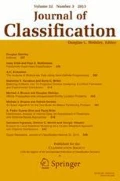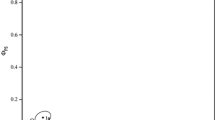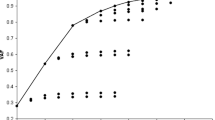Abstract
Graphical representation of nonsymmetric relationships data has usually proceeded via separate displays for the symmetric and the skew-symmetric parts of a data matrix. DEDICOM avoids splitting the data into symmetric and skewsymmetric parts, but lacks a graphical representation of the results. Chino's GIPSCAL combines features of both models, but may have a poor goodness-of-fit compared to DEDICOM. We simplify and generalize Chino's method in such a way that it fits the data better. We develop an alternating least squares algorithm for the resulting method, called Generalized GIPSCAL, and adjust it to handle GIPSCAL as well. In addition, we show that Generalized GIPSCAL is a constrained variant of DEDICOM and derive necessary and sufficient conditions for equivalence of the two models. Because these conditions are rather mild, we expect that in many practical cases DEDICOM and Generalized GIPSCAL are (nearly) equivalent, and hence that the graphical representation from Generalized GIPSCAL can be used to display the DEDICOM results graphically. Such a representation is given for an illustration. Finally, we show Generalized GIPSCAL to be a generalization of another method for joint representation of the symmetric and skew-symmetric parts of a data matrix.
Similar content being viewed by others
References
CARROLL, J. D., and CHANG, J.-J. (1970), “Analysis of Individual Differences in Multidimensinal Scaling Via an n-way Generalization of ‘Eckart-Young’ Decomposition,”Psychometrika, 35, 283–319.
CHINO, N. (1978), “A Graphical Technique for Representing Asymmetric Relationships Between n Objects,”Behaviormetrika, 5, 23–40.
CHINO, N. (1980), “A Unified Geometrical Interpretation of the MDS Techniques for the Analysis of Asymmetry and Related Techniques” Paper presented at the Symposium on Asymmetric Multidimensional Scaling at the Spring Meeting of the Psychometric Society, Iowa, May, 1980.
CHINO, N. (1990), “A Generalized Inner Product Model for the Analysis of Asymmetry,”Behaviormetrika, 27, 25–46.
CHINO, N. (1991), “A Critical Review for the Analysis of Asymmetric Relational Data,”Bulletin of the Faculty of Letters of Aichi Gakuin University, 21, 31–52.
CHINO, N., and SHIRAIWA, K. (1993), “Geometrical Structures of Some Non-distance Models for Asymmetric MDS,”Behaviormetrika, 20, 35–47.
CONSTANTINE, A.G., and GOWER, J.C. (1978), “Graphical Representations of Asymmetric Matrices,”Applied Statistics, 27, 297–304.
DE LEEUW, J., and HEISER, W.J. (1982), “Theory of Multidimensional Scaling with Restrictions on the Configuration,” inHandbook of Statistics, Vol.2, Eds., P.R. Krishnaiah, and L.N. Kanal, Amsterdam: North Holland, 285–316.
DESARBO, W.S., and DE SOETE, G. (1984), “On the Use of Hierarchical Clustering for the Analysis of Nonsymmetric Proximities,”Journal of Consumer Research, 11, 601–610.
ECKART, C., and YOUNG, G. (1936), “The Approximation of One Matrix by Another of Lower Rank,”Psychometrika, 1, 211–218.
ESCOUFIER, Y., and GRORUD, A. (1980), “Analyse factorielle des matrices carrées non symmetriques [Factor analysis of asymmetric square matrices],” inData Analysis and Informatics, Eds., E. Diday, L. Lebart, J.P. Pagès, and R. Tomassone, Amsterdam: North Holland, 263–276.
GABRIEL, K.R. (1971), “The Biplot Graphic Display of Matrices with Application to Principal Components Analysis,”Biometrika, 58, 453–467.
GOWER, J.C. (1966), “Some Distance Properties of Latent Root and Vector Methods Used in Multivariate Analysis,”Biometrika, 53, 325–338.
GOWER, J.C. (1977), “The Analysis of Asymmetry and Orthogonality,” inRecent Developments in Statistics, Eds., J.R. Barra, F. Brodeau, G. Romier, and B. van Cutsem, Amsterdam: North Holland, 109–123.
GOWER, J.C. and ZIELMAN, B. (1992), “Some Remarks on Orthogonality in the Analysis of Asymmetry,” Research Report RR-92-08, University of Leiden, Department of Data Theory.
HARSHMAN, R.A. (1978), “Models for Analysis of Asymmetrical Relationships Among N Objects or Stimuli,” Paper presented at the First Joint Meeting of the Psychometric Society and the Society for Mathematical Psychology, Hamilton, Ontario, August.
HARSHMAN, R.A. (1981), “DEDICOM Multidimensional Analysis of Skew-symmetric Data. Part 1: Theory,” Unpublished technical memorandum, Bell Laboratories, Murray Hill, NJ.
HARSHMAN, R.A., GREEN, P.E., WIND, Y., and LUNDY, M.E. (1982), “A Model for the Analysis of Asymmetric Data in Marketing Research,”Marketing Science, 1, 205–242.
KIERS, H.A.L., TEN BERGE, J.M.F., TAKANE, Y., and DE LEEUW, J. (1990), “A Generalization of Takane's Algorithm for DEDICOM,”Psychometrika, 55, 151–158.
TEN BERGE, J.M.F. (1991), “A General Solution for a Class of Weakly Constrained Linear Regression Problems,”Psychometrika, 56, 601–609.
TORGERSON, W.S. (1958),Theory and Methods of Scaling, New York: Wiley.
ZIELMAN, B., and HEISER, W.J. (1991), “Spatial Representations of Asymmetric Proximities,” Research Report RR-91-10, University of Leiden, Department of Data Theory.
ZIELMAN, B., and HEISER, W.J. (1993), “Analysis of Asymmetry by a Slide Vector,”Psychometrika, 58, 101–114.
Author information
Authors and Affiliations
Additional information
This research has been made possible by a fellowship from the Royal Netherlands Academy of Arts and Sciences to the first author, and by research grant number A6394 to the second author, from the Natural Sciences and Engineering Research Council of Canada. The authors are obliged to Jos ten Berge and Naohito Chino for stimulating comments.
Rights and permissions
About this article
Cite this article
Kiers, H.A.L., Takane, Y. A generalization of GIPSCAL for the analysis of nonsymmetric data. Journal of Classification 11, 79–99 (1994). https://doi.org/10.1007/BF01201024
Issue Date:
DOI: https://doi.org/10.1007/BF01201024




